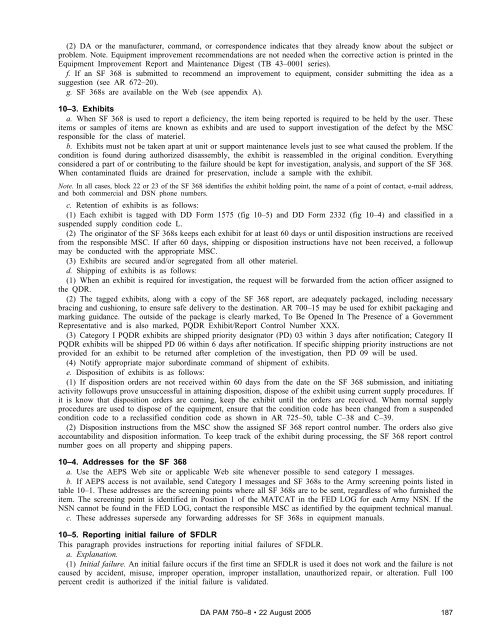The Army Maintenance Management System (TAMMS) Users Manual
The Army Maintenance Management System (TAMMS) Users Manual
The Army Maintenance Management System (TAMMS) Users Manual
Create successful ePaper yourself
Turn your PDF publications into a flip-book with our unique Google optimized e-Paper software.
(2) DA or the manufacturer, command, or correspondence indicates that they already know about the subject or<br />
problem. Note. Equipment improvement recommendations are not needed when the corrective action is printed in the<br />
Equipment Improvement Report and <strong>Maintenance</strong> Digest (TB 43–0001 series).<br />
f. If an SF 368 is submitted to recommend an improvement to equipment, consider submitting the idea as a<br />
suggestion (see AR 672–20).<br />
g. SF 368s are available on the Web (see appendix A).<br />
10–3. Exhibits<br />
a. When SF 368 is used to report a deficiency, the item being reported is required to be held by the user. <strong>The</strong>se<br />
items or samples of items are known as exhibits and are used to support investigation of the defect by the MSC<br />
responsible for the class of materiel.<br />
b. Exhibits must not be taken apart at unit or support maintenance levels just to see what caused the problem. If the<br />
condition is found during authorized disassembly, the exhibit is reassembled in the original condition. Everything<br />
considered a part of or contributing to the failure should be kept for investigation, analysis, and support of the SF 368.<br />
When contaminated fluids are drained for preservation, include a sample with the exhibit.<br />
Note. In all cases, block 22 or 23 of the SF 368 identifies the exhibit holding point, the name of a point of contact, e-mail address,<br />
and both commercial and DSN phone numbers.<br />
c. Retention of exhibits is as follows:<br />
(1) Each exhibit is tagged with DD Form 1575 (fig 10–5) and DD Form 2332 (fig 10–4) and classified in a<br />
suspended supply condition code L.<br />
(2) <strong>The</strong> originator of the SF 368s keeps each exhibit for at least 60 days or until disposition instructions are received<br />
from the responsible MSC. If after 60 days, shipping or disposition instructions have not been received, a followup<br />
may be conducted with the appropriate MSC.<br />
(3) Exhibits are secured and/or segregated from all other materiel.<br />
d. Shipping of exhibits is as follows:<br />
(1) When an exhibit is required for investigation, the request will be forwarded from the action officer assigned to<br />
the QDR.<br />
(2) <strong>The</strong> tagged exhibits, along with a copy of the SF 368 report, are adequately packaged, including necessary<br />
bracing and cushioning, to ensure safe delivery to the destination. AR 700–15 may be used for exhibit packaging and<br />
marking guidance. <strong>The</strong> outside of the package is clearly marked, To Be Opened In <strong>The</strong> Presence of a Government<br />
Representative and is also marked, PQDR Exhibit/Report Control Number XXX.<br />
(3) Category I PQDR exhibits are shipped priority designator (PD) 03 within 3 days after notification; Category II<br />
PQDR exhibits will be shipped PD 06 within 6 days after notification. If specific shipping priority instructions are not<br />
provided for an exhibit to be returned after completion of the investigation, then PD 09 will be used.<br />
(4) Notify appropriate major subordinate command of shipment of exhibits.<br />
e. Disposition of exhibits is as follows:<br />
(1) If disposition orders are not received within 60 days from the date on the SF 368 submission, and initiating<br />
activity followups prove unsuccessful in attaining disposition, dispose of the exhibit using current supply procedures. If<br />
it is know that disposition orders are coming, keep the exhibit until the orders are received. When normal supply<br />
procedures are used to dispose of the equipment, ensure that the condition code has been changed from a suspended<br />
condition code to a reclassified condition code as shown in AR 725–50, table C–38 and C–39.<br />
(2) Disposition instructions from the MSC show the assigned SF 368 report control number. <strong>The</strong> orders also give<br />
accountability and disposition information. To keep track of the exhibit during processing, the SF 368 report control<br />
number goes on all property and shipping papers.<br />
10–4. Addresses for the SF 368<br />
a. Use the AEPS Web site or applicable Web site whenever possible to send category I messages.<br />
b. If AEPS access is not available, send Category I messages and SF 368s to the <strong>Army</strong> screening points listed in<br />
table 10–1. <strong>The</strong>se addresses are the screening points where all SF 368s are to be sent, regardless of who furnished the<br />
item. <strong>The</strong> screening point is identified in Position 1 of the MATCAT in the FED LOG for each <strong>Army</strong> NSN. If the<br />
NSN cannot be found in the FED LOG, contact the responsible MSC as identified by the equipment technical manual.<br />
c. <strong>The</strong>se addresses supersede any forwarding addresses for SF 368s in equipment manuals.<br />
10–5. Reporting initial failure of SFDLR<br />
This paragraph provides instructions for reporting initial failures of SFDLR.<br />
a. Explanation.<br />
(1) Initial failure. An initial failure occurs if the first time an SFDLR is used it does not work and the failure is not<br />
caused by accident, misuse, improper operation, improper installation, unauthorized repair, or alteration. Full 100<br />
percent credit is authorized if the initial failure is validated.<br />
DA PAM 750–8 22 August 2005<br />
187

















